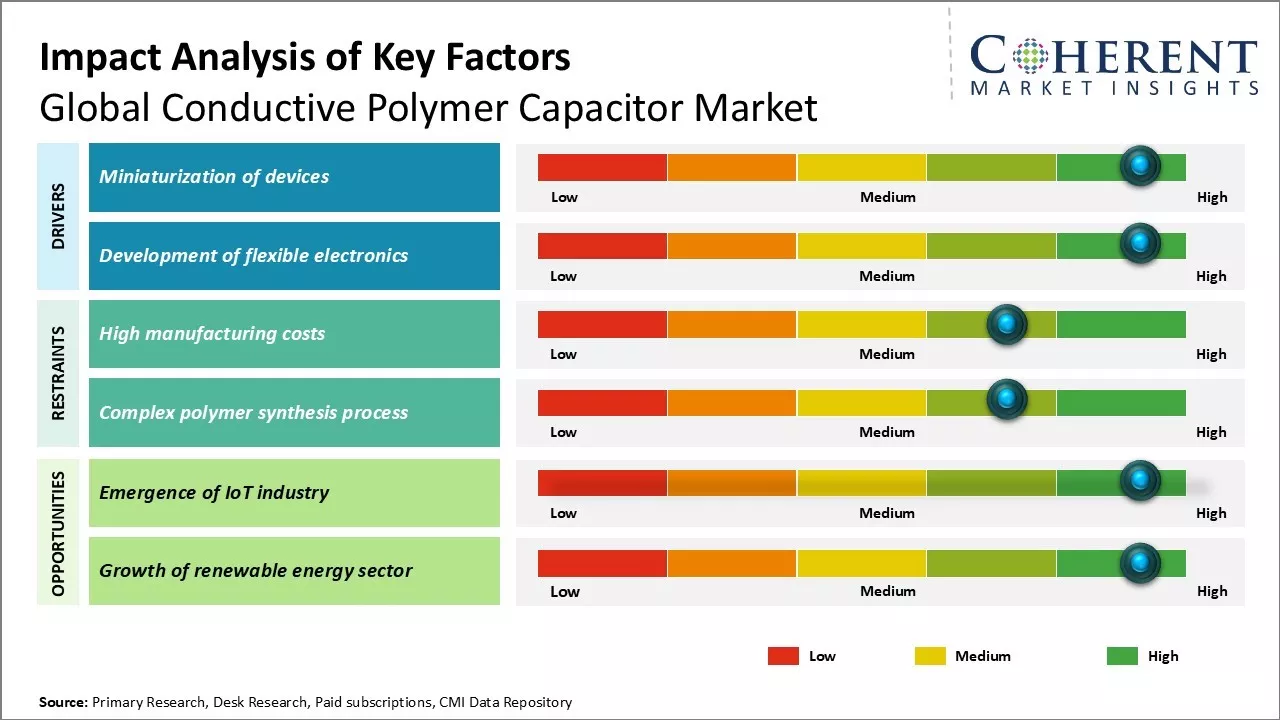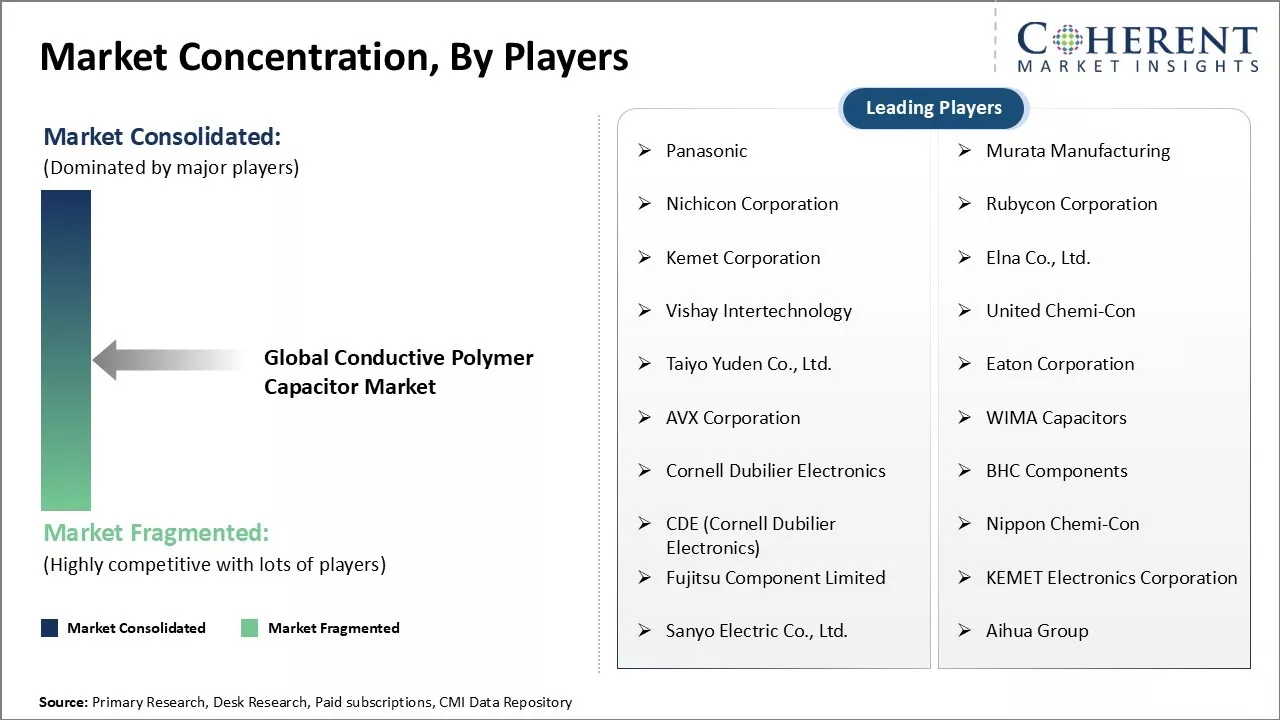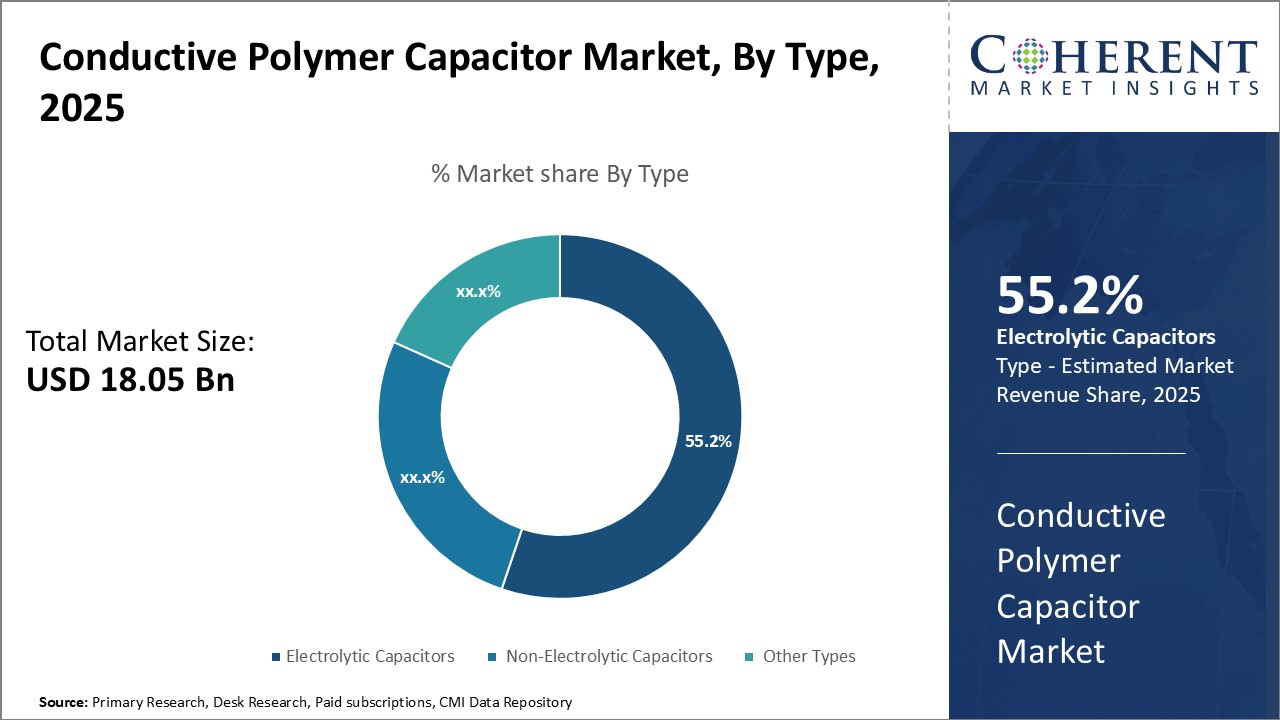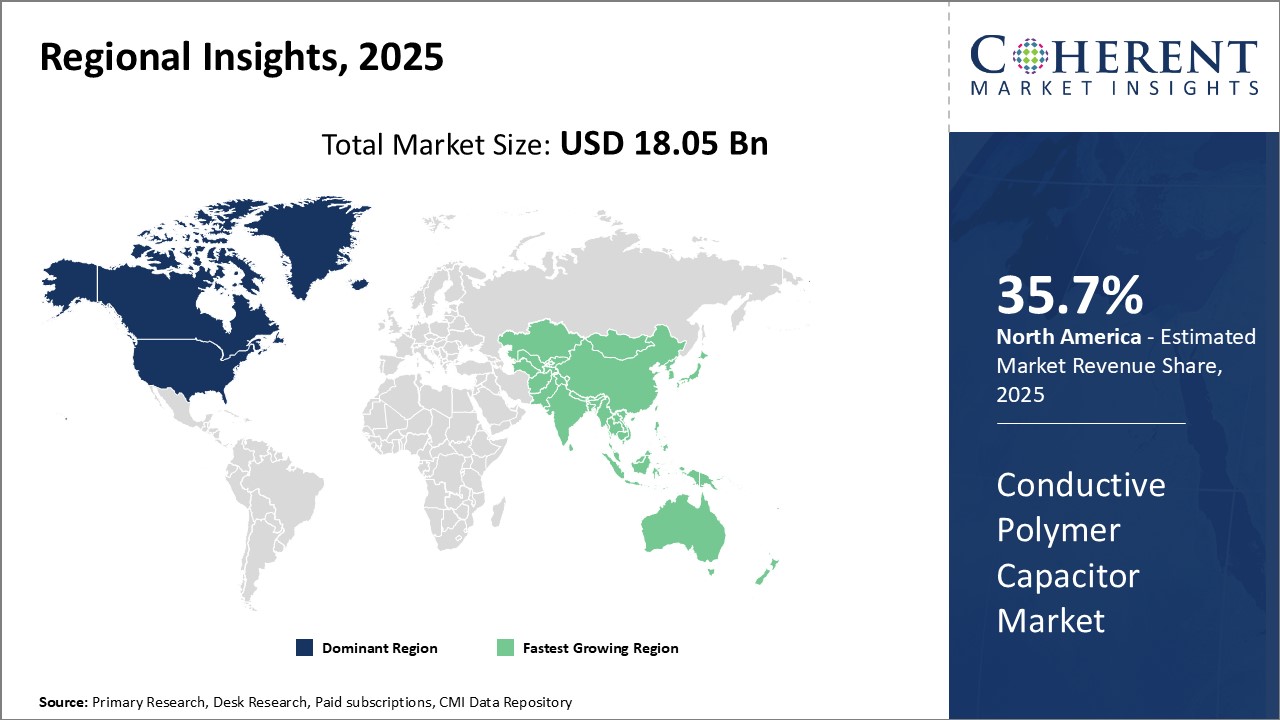The global conductive polymer capacitor market is estimated to be valued at USD 18.05 Bn in 2025 and is expected to reach USD 39.19 Bn by 2032, exhibiting a compound annual growth rate (CAGR) of 11.7% from 2025 to 2032.

Discover market dynamics shaping the industry: Request sample copy
The growth of the global conductive polymer capacitor market is driven by rising demand from the automotive industry for applications such as electric power steering systems, and increasing integration of conductive polymer capacitors in consumer electronic devices such as smartphones, laptops, and tablets for functions such as power management and noise filtering. The market is gaining traction owing to properties offered by conductive polymer capacitors such as high energy density, small size, light weight, and resistance to moisture and voltage. Moreover, ongoing replacement of film capacitors with conductive polymer capacitors in numerous industrial applications due to their superior functionality and performance is expected to propel the market growth during the forecast period.
Miniaturization of devices
The miniaturization of consumer electronics has been one of the biggest drivers for innovation in recent years. As devices get smaller and compact, the demand for smaller components that can fit into tight spaces has also increased significantly. Conductive polymer capacitors have emerged as one of the ideal solutions owing to their flexibility and small size. Unlike traditional ceramic and electrolytic capacitors, conductive polymer capacitors can be manufactured in very small dimensions without compromising on performance. This property has made them very attractive for use in various portable devices such as smartphones, tablets, wearables, and other consumer electronics.
As smartphone and tablet manufacturers strive to make devices thinner and lighter with each new generation, the internal components also need to shrink in order to free up more internal space. Conductive polymer capacitors have enabled device manufacturers to design ultra-thin and slim devices by occupying minimal space on the circuit board. Their small footprint combined with high energy density allows fitting more capacitance into tight spaces inside compact devices. This has significantly boosted their use in applications such as power management circuits, audio circuits, and other areas where precise capacitance is required in less space. The miniaturization trend is further motivating smartphone and tablet manufacturers to completely replace larger conventional types of capacitors with ultra-thin conductive polymer capacitors.

Get actionable strategies to beat competition: Request sample copy
Development of Flexible Electronics
The past few years have seen tremendous interest from researchers and manufacturers to develop innovative flexible and bendable electronic devices. Unlike conventional rigid circuit boards, flexible electronics can conform to non-flat surfaces and can even be rolled up or folded. Such flexible form factors allow for entirely new form factors and applications not possible with traditional electronics. However, incorporating components onto flexible substrates poses unique challenges compared to rigid PCBs. While flexible displays and sensors have progressed significantly, developing flexible power sources and energy storage solutions is crucial for truly flexible devices.
This is where conductive polymer capacitors have emerged as the ideal solution owing to their inherent flexibility and bendability. They can easily be printed or coated directly onto thin flexible plastic films without compromising on performance. The resulting flexible energy storage films can simply be integrated into the design of flexible electronics. Products ranging from flexible displays and screens to wearable devices, smart labels and e-skin require flexible energy solutions. Conductive polymer capacitors have been widely adopted in these applications due to their flexibility and ability to withstand bending/folding without damage. Continuous innovations to improve properties such as flexibility profile and bending lifecycle have unlocked newer possibilities and use cases for flexible electronics. This growing field of flexible devices is expected to drive tremendous opportunities for conductive polymer capacitors in the coming years.
Key Takeaways from Analyst:
The global conductive polymer capacitor market is expected to witness steady growth over the forecast period driven by the expanding consumer electronics sector. The miniaturization of devices is prompting electronics manufacturers to prefer thin and light capacitors like conductive polymer capacitors over traditional alternatives. Conductive polymer capacitors offer advantages such as high reliability and stable performance over wide temperature range and low ESR which make them suitable for applications in smartphones, laptops, tablets, and other consumer devices.
However, high material costs compared to traditional capacitors may limit their mass adoption. Fluctuating prices of raw materials used in manufacturing conductive polymers is also a concern for market participants. Nevertheless, ongoing R&D towards developing cost-effective formulations and manufacturing processes is likely to address this challenge.
The North America region, , currently dominates the global conductive polymer capacitor market. This can be attributed to the large presence of electronics manufacturing industry in the region. North America and Europe are other major markets driven by established electronics sectors. Key players could gain by strengthening their distribution networks in fast-growing emerging economies.
Market Challenges: High manufacturing costs
One of the key challenges faced by the global conductive polymer capacitor market is high manufacturing costs. Conductive polymer capacitors require complex manufacturing processes that involve various chemical and electrical engineering steps. The production of high-quality conductive polymer materials itself is a costly process due to stringent purity and consistency requirements. Additionally, thin-film deposition, patterning, and multilayer stacking techniques employed in manufacturing conductive polymer capacitor chips lead to high capital investments and operating expenditures. Ensuring low defect rates and high yields further increases costs. The barriers to automation and mass production scalability in some of these production stages pose technology and cost challenges. Product miniaturization needs and rising performance standards from the electronics industry exert additional cost pressure on manufacturers. Addressing issues around economies of scale, supply chain management, and technology innovations would be crucial for participants to counter the impact of high costs and achieve sustainable profitability.
Market Opportunities: Emergence of IoT industry
The growth of the Internet of Things (IoT) industry presents significant opportunities for the global conductive polymer capacitor market. IoT connectivity in various fields such as industrial automation, wearable devices, smart home appliances, connected vehicles, and others will necessitate wider integration of electronic components capable of supporting high operating frequencies, compact form factors, and rugged working environments. Conductive polymer capacitors address these needs of the fast-growing IoT ecosystem through their properties such as small size, lightweight, flexibility, high current handling, and wide operating temperature range. Manufacturers are developing application-specific conductive polymer capacitors suitable for power management, signal coupling, and energy storage requirements in various IoT devices and sensor nodes. The extensive implementation of IoT-based technologies across industries is expected to substantially increase the demand for conductive polymer capacitors in the coming years. Original equipment manufacturers and IoT platform providers are also collaborating with capacitor vendors to develop innovative solutions, driving advances and commercialization in this field.

Discover high revenue pocket segments and roadmap to it: Request sample copy
Insights by type: Growing miniaturization demands
In terms of type, electrolytic capacitors is expected to contribute 55.2% share of the market in 2025, owing to ever-growing miniaturization demands. The global conductive polymer capacitor market in terms of type is dominated by the electrolytic capacitors segment. Electrolytic capacitors contribute the highest share primarily owing to the ever-growing demand for the miniaturization of electronic components from end-use industries like consumer electronics and automotive.
Unlike traditional aluminum electrolytic capacitors, conductive polymer capacitors can be manufactured in much smaller sizes without compromising on capacitance. This makes them suitable for use in various space-constrained applications across diverse industries. As gadgets and devices continue to shrink in size while incorporating more complex circuitry and functions, the need for ultra-compact capacitors becomes imperative. Conductive polymer electrolytic capacitors help meet this need excellently due to their smaller footprints.
Insights by application: Rapid product innovation and demand for longer battery life
In terms of application, consumer electronics is expected to contribute 34.9% share of the market in 2025. This is mainly because consumer electronics is an incredibly dynamic industry characterized by constant product innovation and rapid replacement cycles. With users increasingly demanding longer battery life from their portable smart devices, conductive polymer capacitors are finding wider adoption in this area.
Consumer electronic giants are continuously developing advanced gadgets with complex features that necessitate compact power sources with high capacitance densities. Conductive polymer capacitors cater perfectly to this requirement. Their small sizes allow ample space for other components in limited dimensions, while also improving energy and power densities of batteries. As innovative consumer electronic products maintain strong market demand globally, conductive polymer capacitors will continue to witness growing utilization.

Need a Different Region or Segment? Customize now
North America has been the dominant region in the global conductive polymer capacitor market over the past decade owing to the strong presence of major manufacturers and OEMs in the region. The region is expected to hold 35.7% of the market share in 2025. The U.S. is home to leading companies such as Panasonic Corporation, AVX Corporation, and KEMET Corporation which have significantly contributed to the regional market growth through extensive R&D investments and new product launches catering to various industrial applications. Moreover, the aerospace and defense industry in the U.S. spends heavily on technological advancements utilizing conductive polymer capacitors, thus driving the regional demand.
The automotive industry in the U.S. and Canada has also picked up pace in incorporating conductive polymer capacitors into electric vehicles and related safety systems. With the focus towards developing sustainable transportation solutions, the adoption of conductive polymers is expected to rise manifold in the coming years. Additionally, North America remains a key exporter of conductive polymer capacitors to other developing markets due to established trade agreements and logistics infrastructure. This has further cemented North America's stronghold in the global market.
On the other hand, the Asia Pacific region has emerged as the fastest growing market for conductive polymer capacitors globally over the past five years. China has dominated the regional market size due to a massive electronics and automotive manufacturing hub coupled with the lowest production costs. The availability of raw materials and cheaper labor has attracted foreign investments as well as spread awareness. Countries like India and South Korea are also aggressively stepping into the fray and eyeing self-reliance in capacitor manufacturing as electronic exports pick up. Overall, the conductive polymer capacitor import-export pricing within the Asia Pacific region has remained competitive over the years, further fueling regional market expansion.
Conductive Polymer Capacitor Market Report Coverage
| Report Coverage | Details | ||
|---|---|---|---|
| Base Year: | 2024 | Market Size in 2025: | USD 18.05 Bn |
| Historical Data for: | 2020 To 2024 | Forecast Period: | 2025 To 2032 |
| Forecast Period 2025 to 2032 CAGR: | 11.7% | 2032 Value Projection: | USD 39.19 Bn |
| Geographies covered: |
|
||
| Segments covered: |
|
||
| Companies covered: |
Panasonic, Murata Manufacturing, Nichicon Corporation, Rubycon Corporation, Kemet Corporation, Elna Co., Ltd., Vishay Intertechnology, United Chemi-Con, Taiyo Yuden Co., Ltd., Eaton Corporation, AVX Corporation, WIMA Capacitors, Cornell Dubilier Electronics, BHC Components, CDE (Cornell Dubilier Electronics), Nippon Chemi-Con, Fujitsu Component Limited, KEMET Electronics Corporation, Sanyo Electric Co., Ltd., and Aihua Group |
||
| Growth Drivers: |
|
||
| Restraints & Challenges: |
|
||
Uncover macros and micros vetted on 75+ parameters: Get instant access to report
*Definition: The global conductive polymer capacitor market refers to the market for conductive polymer capacitors produced and distributed on a global scale. Conductive polymer capacitors are electronic components that utilize conducting polymers as the dielectric material instead of traditional inorganic materials like ceramic or aluminum oxide. They offer benefits like high volumetric efficiency, lightweight and compact construction, low ESR and ESL, and the ability to operate at high frequencies. Major applications include consumer electronics, home appliances, industrial equipment, automotive electronics, and medical devices.
Share
Share
About Author
Pankaj Poddar is a seasoned market research consultant with over 12 years of extensive experience in the fast-moving consumer goods (FMCG) and plastics material industries. He holds a Master’s degree in Business Administration with specialization in Marketing from Nirma University, one of India’s reputed institutions, which has equipped him with a solid foundation in strategic marketing and consumer behavior.
As a Senior Consultant at CMI for the past three years, he has been instrumental in harnessing his comprehensive understanding of market dynamics to provide our clients with actionable insights and strategic guidance. Throughout his career, He has developed a robust expertise in several key areas, including market estimation, competitive analysis, and the identification of emerging industry trends. His approach is grounded in a commitment to understanding client needs thoroughly and fostering collaborative relationships. His dedication to excellence and innovation solidifies his role as a trusted advisor in the ever-evolving landscape of not only FMCG but also chemicals and materials markets.
Missing comfort of reading report in your local language? Find your preferred language :
Transform your Strategy with Exclusive Trending Reports :
Frequently Asked Questions
Joining thousands of companies around the world committed to making the Excellent Business Solutions.
View All Our Clients
US Reciprocal Tax Impact Analysis On Conductive Polymer Capacitor Market
Stay updated on tariff changes with expert insights and timely information